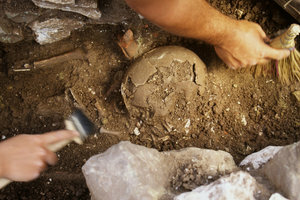The C14 method for determining age
You may have wondered at one time that finds from excavations can be assigned to a specific epoch, even though the finds consisted of only fragments. The C14 method that is mostly used here is currently the tool of archeology to determine the age.

The C14 method is based on the findings of the chemist Willard Libby
- As mysterious as the concept of the C14 method may sound, it is as easy to explain on a scientific basis. Even if you don't have a college degree physics you will understand the process used to determine the age.
- All you need is your trust in a few physical laws, which you do not necessarily have to understand immediately.
- At the time of World War II, chemist Willard Frank Libby was researching cosmic rays. In doing so, he discovered laws related to the neutrons in radiation and the nitrogen in the earth's atmosphere.
- He observed how the balanced composition of protons and neutrons changes in favor of neutrons. The resulting C14 is radioactive and doomed after its association with plants.
- Of course, it takes a strong curiosity to be able to use this discovery to determine the age of archaeological finds. Libby was eventually awarded the Nobel Prize in Physics in 1960 for discovering the radiocarbon method. By 2013, this method of age determination had not found a worthy successor.
Determining the age of paper is also becoming increasingly popular with private individuals. Old …
What is this age determination based on?
- With the C14 method, for example, the age of an archaeological find can be determined quite precisely. Sometimes even the smallest fragments are enough to give an object its place in the Story can be assigned fairly precisely.
- Scientists take advantage of the fact that plants accumulate a radioactive isotope of carbon during their lifetime, which decays after they die. The half-life - i.e. the time in which the accumulation has halved - is known for carbon 14 (C14) and at 5568 years can be regarded as quite high.
- This long period of time gives the researcher the opportunity, based on special calculations that may also refer to one or the other unknown component that determine the age to be able to
- To do this, it was necessary to use the laboratory measurement developed by Willard Frank Libby in the early 1950s to determine the value that existed before the decay began.
- The archaeologist has every right to assume that all the materials found in one and the same layer of earth experienced their demise at the same time. So the scientist concludes based on the remains of plants or wood, the age of which he can prove with the C14 method can, on the age of the finds that could be found in the relevant layer of earth, and sets them according to age even.
Libby used counting tubes to determine his age with the C14 method he invented. The Geiger counter, which you are probably familiar with, is probably the most well-known measuring device of this type. These tubes document the beta particles emanating from the C14 nuclei, which are emitted by the reaction to an introduced noble gas. Only a few hundred milligrams of material are required for this.
How helpful do you find this article?



